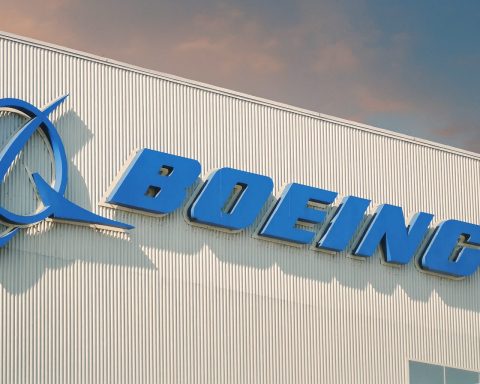- On Aug. 13, 2025, the S&P 500 posted a fresh all-time closing high for the second straight day while the Nasdaq also hit a record and the Dow rose about 1% (over 400 points).
- Alphabet’s Google announced it will spend an additional $9 billion in Oklahoma over the next two years to expand its AI and cloud infrastructure, and Google raised its 2025 capital expenditures to $85 billion from $75 billion.
- Nvidia and AMD struck a deal with Washington to resume selling advanced AI chips to China, in exchange for sharing 15% of the revenue from those sales with the U.S. government, and Nvidia briefly reached a $4.5 trillion intraday market cap on Aug. 12.
- Apple’s stock climbed about 1.6% after reports that the company is plotting expansion into AI-powered robots, home security, and smart displays.
- Cisco Systems reported AI-focused orders above $800 million in Q4 and projected over $2 billion of AI-related revenue for fiscal 2025, with CEO Chuck Robbins saying the company will be a core systems provider for major AI training clusters.
- SoundHound AI delivered Q2 revenue more than tripling year over year, swung to positive net income, and raised its full-year 2025 revenue outlook to $160–$178 million, while launching its Vision AI platform and an automotive voice assistant partnership.
- C3.ai announced fiscal Q1 2026 revenue guidance of about $70.2–$70.4 million, well below consensus near $100 million, and its founder Tom Siebel resigned for health reasons, sending the stock down about 25%.
- CoreWeave posted a larger-than-expected quarterly loss as operating expenses ballooned to $1.19 billion, even as revenue beat and the company carries roughly $8 billion of debt, with shares down about 21%.
- Advent International agreed to acquire Sapiens International for $2.5 billion in cash at a 47% premium, signaling AI-driven consolidation in the insurance software sector.
- OpenAI was reportedly exploring a deal to let employees cash out some shares at a $500 billion valuation—up from about $300 billion—illustrating how feverish AI capital and talent competition have become.
Market Rally Fueled by AI Hype and Fed Optimism
Global markets surged mid-week as enthusiasm around artificial intelligence (AI) converged with encouraging economic signals. On Wednesday Aug. 13, Wall Street’s major indexes hit fresh records – the S&P 500 notched a new all-time closing high for the second straight day and the tech-heavy Nasdaq also set a record, buoyed in part by AI-driven gains [1] [2]. Cooling inflation data reinforced hopes the Federal Reserve will soon cut interest rates, turbocharging risk appetite in equities [3] [4]. The Dow Jones Industrial Average jumped 1% (over 400 points) to approach its first record close since last year [5]. “Valuations are elevated… at the end of the day, the key will be delivery of earnings,” noted Katherine Bordlemay of Goldman Sachs, suggesting investors are now looking for real results to justify sky-high AI valuations [6]. Smaller stocks joined the rally – the Russell 2000 index surged 2% to its highest level of 2025 as investors piled into growth plays [7] [8].
Overseas markets mirrored the euphoria. In Asia, Japan’s tech conglomerate SoftBank saw its shares soar over 13% to a record high after smashing earnings forecasts, a rally fueled by its massive investments in AI ventures [9] [10]. SoftBank’s April–June net profit swung to ¥421.8 billion (about $2.9 billion), prompting analysts to laud “thematic tailwinds” from AI for bolstering its portfolio value [11] [12]. Meanwhile in Taiwan, Foxconn – the world’s largest electronics manufacturer – reported a 27% jump in Q2 profit and issued bullish forecasts thanks to exploding demand for AI servers [13] [14]. Foxconn expects its AI server revenues to leap 170% year-on-year in the third quarter, as cloud giants like Amazon, Microsoft, and Google pour billions into data centers for AI research [15] [16]. “AI has been the primary growth driver so far this year,” Foxconn’s CEO Kathy Yang said, noting that its enterprise server sales just overtook iPhone assembly as the firm’s top revenue source [17] [18]. She cautioned, however, that “close attention is needed” to trade tariffs and currency swings that could cloud the outlook [19]. That warning proved prescient as geopolitical cross-currents – especially between the U.S. and China – began to temper some of the AI exuberance.
Tech Titans Double-Down on AI Ambitions
The “Magnificent 7” mega-cap tech companies largely held firm near record levels, underscoring their central role in the AI boom. Microsoft, Alphabet (Google), Amazon, Apple, Meta, Nvidia, and Tesla have become “must-own” pillars of many portfolios, with a recent Bank of America survey again calling big-cap AI stocks the world’s most crowded trade [20]. This week brought fresh evidence of their aggressive AI investments. Alphabet’s Google announced it will spend an additional $9 billion in Oklahoma over the next two years to expand its AI and cloud infrastructure [21]. The plan includes building a new data center campus and expanding an existing facility to bolster U.S. capacity for AI services [22] [23]. Google’s capital expenditures for 2025 were already raised to $85 billion (from $75 billion) to fund such projects [24]. The company and its Big Tech peers defend these staggering outlays as “essential to fueling growth” amid fierce global competition [25] [26]. Indeed, Google’s move comes as rivals like OpenAI, Amazon, and Anthropic are racing to build data centers and train talent; more than 100 universities have signed on to Google’s $1 billion AI education initiative to cultivate the next generation of AI workers [27] [28].
Apple also grabbed headlines – its stock climbed ~1.6% after reports emerged that the company is “plotting expansion into AI-powered robots, home security and smart displays,” signaling an entry into new AI-driven consumer products [29]. While Apple has been relatively quiet about AI compared to peers, the leak suggests it is ramping up efforts to integrate AI in future devices and services. Amazon likewise made news by expanding its same-day grocery delivery network, and its shares rose over 1%, reflecting how e-commerce and cloud players are leveraging AI to gain an edge [30] [31]. And Meta Platforms (Facebook), which has spent heavily on AI R&D, is reportedly acquiring multiple AI startups to bolster its conversational AI capabilities – part of an ongoing talent arms race among tech giants [32]. In short, the Big Tech players continue to pour money into AI – from data centers and chips to software and talent – reinforcing Wall Street’s view that these companies will remain “AI front-runners” with durable moats [33]. Their stocks mostly “held steady” over the past two days [34], suggesting much of the good AI news is already priced in. Still, the sheer scale of their investments and new project announcements (like Google’s $9B pledge) gave investors confidence that the AI revolution is far from slowing down.
Chipmakers Surge on U.S.–China Deal, But Tensions Simmer
Semiconductor stocks – the backbone of the AI revolution – enjoyed a rally after a major breakthrough in U.S.–China tech trade. Nvidia and Advanced Micro Devices (AMD) struck a landmark agreement with Washington that allows them to resume selling advanced AI chips to China, in exchange for sharing 15% of the revenue from those sales with the U.S. government [35]. The White House confirmed the novel arrangement on Tuesday, calling it a “creative idea and solution” that could “expand in the future to other companies,” hinting that firms like Intel or Qualcomm might get similar carve-outs [36] [37]. Investors cheered this resolution of export curbs – Nvidia’s stock jumped to a fresh intraday record on Aug. 12 and continued upward, briefly valuing the GPU giant at roughly $4.5 trillion in market cap [38]. “We see this as a creative solution,” one analyst noted, as it allows Nvidia and AMD to keep tapping China’s huge AI market while assuaging U.S. security concerns via profit-sharing [39] [40]. AMD shares also rose ~1.6% on the news [41]. By Wednesday’s close, there was some profit-taking – Nvidia and Google ended slightly in the red that day [42] – but both stocks remained near peak levels, reflecting optimism that regained access to China will boost future sales.
Yet geopolitical tensions quickly resurfaced, underscoring that the chip trade war is far from over. In Beijing, regulators have begun pumping the brakes on Nvidia’s newest AI chips. Sources told Reuters that Chinese authorities summoned tech giants Tencent, ByteDance, Baidu and others in recent weeks, questioning why they are buying Nvidia’s cutting-edge H20 processors instead of domestic alternatives [43] [44]. Officials “expressed concerns over information risks” – even fearing that technical data shared for U.S. export reviews could expose sensitive Chinese company info [45] [46]. While China hasn’t banned purchases of Nvidia’s H20 (a U.S. ban on the chip was actually lifted last month) [47], this regulatory pressure is “likely to complicate Nvidia’s efforts to boost China sales,” Reuters noted [48]. Nvidia stressed that the H20 is “not a military product or for government infrastructure” and that China has domestic chips for its official needs [49] [50]. Even so, the push-pull dynamic is evident: Beijing’s wariness could dampen demand, even as Washington is easing some curbs. In a striking example of the cat-and-mouse enforcement at play, U.S. authorities have secretly embedded location trackers in certain shipments of AI chips to detect any illegal diversions to China [51] [52]. Tiny trackers were found in some Dell and Super Micro servers containing Nvidia and AMD chips, as part of an effort to catch illicit re-export or smuggling [53]. This “shows the lengths to which the U.S. has gone” to uphold export controls – even as the Trump administration simultaneously relaxes some chip curbs and extends tariff truces with China [54]. The conflicting signals highlight a tense backdrop for chipmakers: on one hand, a lucrative Chinese market is reopening (albeit with a 15% toll to Uncle Sam); on the other, Chinese regulators and U.S. security agencies are keeping a very watchful eye. For investors, the net takeaway was still positive – AI chip demand remains red-hot globally, and the revenue-sharing deal removed a major overhang. As proof of momentum, Nvidia’s data center business reportedly hit record sales, and “sovereign AI” initiatives (like national AI supercomputers) are expected to drive the next leg of growth in 2026 [55]. But the bumpy U.S.–China relationship means chip stocks could stay volatile with each new policy twist. “The backdrop of U.S.–China rivalry in AI looms as a medium-term risk,” one market strategist warned, advising vigilance even as the sector soars [56].
Earnings: AI Winners Soar, Misses Hammer Stocks
This week delivered a stark divide between AI “haves” and “have-nots” as a flurry of earnings reports and forecasts sent some stocks skyrocketing and others into freefall. On the winning side was Cisco Systems, a legacy tech player now cashing in on the AI wave. Cisco reported stronger-than-expected results and projected upbeat revenue ahead, crediting a boom in orders for AI-related networking gear [57]. Demand from cloud titans is so robust that Cisco’s AI-focused orders exceeded $800 million in Q4, topping $2 billion for fiscal 2025 – more than double the company’s original target [58]. CEO Chuck Robbins said the company will be a “core systems provider” for major AI training clusters going forward [59]. Cisco’s forward guidance came in slightly above analysts’ estimates, and an Edward Jones analyst noted there is “incremental spending to beef up infrastructure to accommodate AI” across enterprises [60]. In response, Cisco’s stock climbed in after-hours trading, reflecting investor cheer that even traditional tech firms are getting an AI revenue boost. Likewise, SoundHound AI, a smaller voice-AI software company, delivered a standout quarter that sent its shares into orbit. The company’s Q2 revenue more than tripled year-on-year and it achieved a surprise swing to positive net income – a rare feat for a young AI firm. SoundHound raised its full-year 2025 sales outlook (now expecting $160–$178 million in revenue) and rolled out new products like its Vision AI platform and an automotive voice assistant partnership with global car brands [61]. Investors rewarded these results by bidding up SoundHound’s stock nearly 50% in the past week alone [62]. The euphoria around its growth trajectory (analysts see ~47% annual revenue CAGR ahead) turned SoundHound into one of the market’s best-performing AI stocks of the moment.
On the other end of the spectrum, several hyped AI names crashed hard after disappointing news. C3.ai, a once high-flying enterprise AI software provider, stunned the market with preliminary results that fell far below expectations. The company revealed its fiscal Q1 2026 revenue would come in around $70.2–$70.4 million – well under the ~$100 million analysts had expected, and even down from $87 million in the same quarter a year prior [63] [64]. Worse, C3.ai’s founder/CEO Tom Siebel resigned due to health reasons, as the company simultaneously announced a reorganization of its sales team. Siebel did not sugarcoat the situation: he blasted the quarter’s sales as “completely unacceptable,” admitting execution had faltered [65]. The stock promptly plunged about 25%, wiping out a quarter of its value in one session [66]. Wall Street analysts swiftly piled on – Oppenheimer downgraded C3.ai to Underperform, warning “business trends [are] likely to get worse before they get better” [67], and D.A. Davidson issued a scathing “ran out of luck” note. Wedbush kept an Outperform rating but slashed its price target from $35 to $23, calling the sales miss “brutal” [68]. The rout in C3.ai underscored how highly volatile and sentiment-driven the smaller AI stocks remain. Another casualty was CoreWeave, a cloud startup that operates AI data centers (and is notably backed by Nvidia). CoreWeave, which IPO’d in March, revealed a bigger-than-expected quarterly loss as its operating expenses ballooned nearly fourfold to $1.19 billion [69] [70]. Despite surging revenue (demand for its Nvidia-powered infrastructure is robust), the red ink spooked investors – CoreWeave’s shares plunged almost 21% on Wednesday following its results [71]. “CoreWeave does not currently generate enough profit to pay all its debt holders, certainly not equity holders,” warned analysts at D.A. Davidson, highlighting the company’s heavy $8 billion debt load [72]. With its post-IPO lockup period expiring this week, Deutsche Bank analysts noted the selling pressure was likely exacerbated by insiders poised to unload shares [73]. Still, CoreWeave’s long-term prospects tie directly to AI demand – it runs 33 AI data centers and its revenue beat forecasts – but as one market expert put it, “It’s an expensive business trying to stay ahead of the game and ensure enough capacity” for the AI services boom [74]. That reality check dragged the stock down despite the overall AI optimism.
BigBear.ai, a small-cap AI analytics firm, added to the carnage after posting weak Q2 results and cutting its guidance. The company’s revenue fell 18% year-on-year and it slashed its full-year outlook, citing delays in certain defense-related programs. BigBear’s stock tumbled roughly 20% on Tuesday (Aug. 12) as the earnings miss and widened loss spooked investors [75] [76]. At one point the shares were down over 30% from their prior close [77]. Nonetheless, some analysts struck an optimistic tone – a top Needham analyst actually raised BigBear’s price target, arguing the pullback was overdone and that the company’s long-term AI/ML opportunities (particularly with U.S. government clients) remain intact [78] [79]. Such contrarian calls did little to stem the immediate sell-off, but they illustrate the bifurcated sentiment in the AI space: believers see transformative growth ahead, while skeptics worry about hype outrunning financial reality. The same pattern played out across many smaller AI-related stocks – extreme moves in both directions. For example, SoundHound’s 50% surge on good news was mirrored by a nearly 50% crash in another AI play,Symbotic, earlier in the week when Walmart (its key partner) scaled back an automation deal (notably Symbotic recovered some losses after clarifying its revenue impact). In short, volatility is king in the AI stock arena: strong results or big contracts can send a stock flying, but any hint of slowdown or execution issues can be devastating. As one trader quipped, “AI stocks have no middle ground right now – it’s feast or famine.”
Deals, Partnerships and Policy Shake-ups
Beyond earnings, strategic deals and policy shifts made headlines in the AI sector during the past 48 hours. In the M&A arena, a notable takeover underscored how traditional industries are racing to adopt AI. Israeli software firm Sapiens International, a provider of insurance software, announced it will be acquired by U.S. private equity giant Advent International for $2.5 billion in cash [80]. The buyout (at a hefty 47% premium to Sapiens’ last stock price) is explicitly aimed at capitalizing on the “AI boom” in the insurance sector [81]. “Insurers are increasingly turning to technology to help unlock growth and profitability… We will work with [Sapiens] to accelerate investment into technology innovation [and] AI,” said Advent director Douglas Hallstrom [82]. Sapiens’ products are used by insurers to automate claims and underwriting with AI, and Advent’s infusion is expected to speed up those AI capabilities. The deal will take Sapiens private and allow Advent to beef up the company’s AI and SaaS offerings away from the quarterly pressures of the public market. It’s a clear sign that AI-driven consolidation is heating up, as deep-pocketed investors target firms that can apply AI to traditionally analog sectors (like insurance). Similarly, in the chip industry, deal-making chatter persists – memory maker Western Digital’s stock popped on Aug. 14 after reports that a long-discussed merger with Kioxia (key to developing AI-friendly storage) may finally be near. And in startup land, Meta Platforms is rumored to be in talks to acquire Scale AI (a data labeling unicorn) as it hunts for top-tier AI talent [83] [84]. Though not confirmed, the mere rumor of Meta eyeing Scale’s 28-year-old CEO (with a “lucrative package”) shows how fiercely Big Tech is competing to “secure talented workers” in AI [85] [86].
On the partnership front, companies are forging alliances to bolster their AI capabilities. Cisco revealed new collaborations, including a partnership with Humain – Saudi Arabia’s state-backed AI company – to build out “sovereign AI” infrastructure in the Middle East [87]. Cisco will also provide tech for Bahrain’s government as it invests in AI and cloud, signaling how Gulf states are teaming with U.S. firms to become regional AI hubs [88]. Elsewhere, IBM and Hugging Face announced a tie-up to train a new open-source AI language model for business applications (leveraging IBM’s Red Hat and cloud assets), aiming to challenge proprietary models from OpenAI and others (this news broke just before the August 13–14 window, but is part of a broader trend of AI collaborations). Even retailers are jumping in: Walmart unveiled a partnership with Alphabet’s Wing to pilot AI-powered drone deliveries – a futuristic effort that grabbed attention though it didn’t move either stock much.
Meanwhile, regulators and policymakers continued grappling with the fast-evolving AI landscape. In Washington, the Biden (Trump) administration’s stance on AI appears to mix deregulation with oversight. President Trump this week extended a pause on new tech tariffs for 90 days – effectively keeping a truce in the trade war through late 2025 [89] – which relieved tech investors worried about supply chain costs. Simultaneously, the White House is drafting guidelines for AI safety and transparency, aiming to hold companies accountable for issues like biased algorithms or deepfakes. The EU is moving forward with its sweeping AI Act (expected to be finalized later this year), and U.S. companies are lobbying to ensure any new rules don’t stifle innovation. One notable legal development: a U.S. court denied Elon Musk’s bid to dismiss a lawsuit by OpenAI, which had accused the Tesla/Twitter boss of allegedly undermining OpenAI through harassment claims [90]. The case, though not directly market-moving, highlighted the intense rivalries and legal battles emerging in the AI field (Musk is backing a rival to OpenAI). And in the private market, OpenAI itself is reportedly exploring a deal to allow employees to cash out some shares at a whopping $500 billion valuation – an eye-popping leap from its last $300 billion valuation and a sign of just how feverish the AI valuations have become [91] [92]. The move would let early OpenAI staff reap rewards ahead of any IPO, and underscores “intense competition” for AI talent – with companies like Meta willing to pay billions for star AI leaders [93].
Outlook: Experts Urge Balance as AI Boom Evolves
With AI stocks dominating headlines and portfolios, many analysts and industry leaders are urging a balanced perspective – equal parts optimism and caution. The consensus is that we are witnessing an AI-driven transformation across tech and industry, but there will inevitably be winners and losers along the way. “AI has been the primary growth driver so far this year,” as Foxconn’s CEO summed up [94], and that sentiment echoes from Silicon Valley to Wall Street. Trillion-dollar companies are remaking themselves around AI, and even century-old industrial firms like Boeing and Deere are embedding AI in everything from design to maintenance. Economists note that AI’s productivity boost could help tame inflation and lift global GDP in coming years, a reason central bankers might welcome its spread. Yet, signs of exuberance – some might say excess – are undeniable. When a small software stock can double or halve in days based on an AI press release, or a private startup can seek half-a-trillion valuation on ChatGPT’s popularity, it raises eyebrows. Notably, even as the S&P 500 and Nasdaq set records, some mega-cap tech stocks slipped mid-week, hinting that investors may be rotating into underpriced opportunities or taking profits [95] [96]. “The dispersion of stock-level returns is at one of the highest levels of the last 30 years,” observed Bordlemay of Goldman Sachs [97] – in other words, picking the right AI winners is crucial, as the tide isn’t lifting all boats equally.
Several financial commentators advise focusing on companies with real earnings and competitive moats in AI, rather than chasing every speculative name. “At the end of the day, the key will be the delivery of earnings,” Bordlemay stressed [98], a reminder that lofty promises must translate into profits to be sustainable. The extreme moves in C3.ai, SoundHound, and CoreWeave this week illustrate this principle: hype alone won’t suffice if numbers disappoint. At the same time, genuine breakthroughs are being rewarded richly. “Positive trading and a friendly regulator make for a powerful combo,” noted IPO strategist Matt Kennedy with regard to the crypto sector’s resurgence [99] [100] – a comment that could just as easily apply to AI stocks if supportive policies (like the U.S.–China chip deal) continue. Industry leaders are also weighing in on responsible growth. Google’s CEO Sundar Pichai (in absentia) has spoken about developing AI “boldly and responsibly,” and the company’s $1 billion investment in AI education shows an eye toward the long game [101]. Likewise, OpenAI’s willingness to restructure its unusual profit cap model indicates even the pioneers are adapting to ensure access to capital and talent [102].
For now, AI remains the market’s main character – driving headlines, stock swings, and corporate strategies by the day. As this 48-hour whirlwind demonstrates, fortunes can flip fast: record highs and blockbuster deals on one side, skepticism and shock misses on the other. “The AI stock frenzy is far from over, but it is evolving,” one report concluded [103]. Investors are learning to discern substance from speculation, even as they ride the historic wave of innovation. The next tests loom just ahead: Nvidia’s own earnings later this month will be a crucial barometer of whether the AI hardware boom is meeting expectations, and any guidance on chip demand (especially from China) could either extend the rally or cool it. Similarly, as more legacy companies like Cisco show their AI cards, we’ll see if AI’s benefits truly spread economy-wide or concentrate in a few winners. In the meantime, analysts urge a bit of prudence amid the gold rush. Or as one portfolio manager put it: “Enjoy the AI party, but don’t forget to check the fundamentals before the music stops.”
Sources: Major news outlets and company releases, including Reuters [104] [105] [106] [107] [108], CNBC, Bloomberg, Investopedia [109] [110], company press releases, and expert commentary from financial analysts and industry leaders. All information is accurate as of August 14, 2025.
References
1. www.reuters.com, 2. www.reuters.com, 3. www.reuters.com, 4. www.investopedia.com, 5. www.investopedia.com, 6. www.reuters.com, 7. www.investopedia.com, 8. www.investopedia.com, 9. www.reuters.com, 10. www.reuters.com, 11. www.reuters.com, 12. www.reuters.com, 13. www.reuters.com, 14. www.reuters.com, 15. www.reuters.com, 16. www.reuters.com, 17. www.reuters.com, 18. www.reuters.com, 19. www.reuters.com, 20. ts2.tech, 21. www.reuters.com, 22. www.reuters.com, 23. www.reuters.com, 24. www.reuters.com, 25. www.reuters.com, 26. www.reuters.com, 27. www.reuters.com, 28. www.reuters.com, 29. www.reuters.com, 30. www.investopedia.com, 31. www.investopedia.com, 32. ts2.tech, 33. ts2.tech, 34. ts2.tech, 35. www.reuters.com, 36. www.reuters.com, 37. www.reuters.com, 38. ts2.tech, 39. ts2.tech, 40. ts2.tech, 41. ts2.tech, 42. www.investopedia.com, 43. www.reuters.com, 44. www.reuters.com, 45. www.reuters.com, 46. www.reuters.com, 47. www.reuters.com, 48. www.reuters.com, 49. www.reuters.com, 50. www.reuters.com, 51. www.reuters.com, 52. www.reuters.com, 53. www.reuters.com, 54. www.reuters.com, 55. www.reuters.com, 56. ts2.tech, 57. www.reuters.com, 58. www.reuters.com, 59. www.reuters.com, 60. www.reuters.com, 61. simplywall.st, 62. simplywall.st, 63. www.investopedia.com, 64. www.investopedia.com, 65. www.investopedia.com, 66. www.investopedia.com, 67. www.investopedia.com, 68. www.investopedia.com, 69. www.reuters.com, 70. www.reuters.com, 71. www.reuters.com, 72. www.reuters.com, 73. www.reuters.com, 74. www.reuters.com, 75. finance.yahoo.com, 76. finance.yahoo.com, 77. www.nasdaq.com, 78. www.tipranks.com, 79. www.tipranks.com, 80. www.reuters.com, 81. www.reuters.com, 82. www.reuters.com, 83. www.reuters.com, 84. www.reuters.com, 85. www.reuters.com, 86. www.reuters.com, 87. www.reuters.com, 88. www.reuters.com, 89. ts2.tech, 90. www.reuters.com, 91. www.reuters.com, 92. www.reuters.com, 93. www.reuters.com, 94. www.reuters.com, 95. www.reuters.com, 96. www.reuters.com, 97. www.reuters.com, 98. www.reuters.com, 99. www.reuters.com, 100. www.reuters.com, 101. www.reuters.com, 102. www.reuters.com, 103. ts2.tech, 104. www.reuters.com, 105. www.reuters.com, 106. www.reuters.com, 107. www.investopedia.com, 108. www.reuters.com, 109. www.investopedia.com, 110. www.investopedia.com







